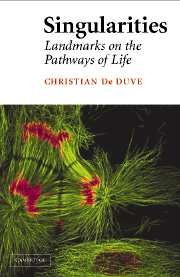Book contents
- Frontmatter
- Contents
- Foreword
- On Christian de Duve: An Editor's Appreciation
- General Introduction
- 1 Building Blocks
- 2 Homochirality
- 3 Protometabolism
- 4 ATP
- 5 Electrons and Protons
- 6 Thioesters
- 7 RNA
- 8 Proteins
- 9 DNA
- 10 Membranes
- 11 Protonmotive Force
- 12 Protometabolism Revisited
- 13 The LUCA
- 14 The First Fork
- 15 Eukaryotes
- 16 Oxygen
- 17 Endosymbionts
- 18 Multicellulars
- 19 Homo
- 20 Evolution
- Final Comments
- Bibliography
- Index
16 - Oxygen
Published online by Cambridge University Press: 18 January 2010
- Frontmatter
- Contents
- Foreword
- On Christian de Duve: An Editor's Appreciation
- General Introduction
- 1 Building Blocks
- 2 Homochirality
- 3 Protometabolism
- 4 ATP
- 5 Electrons and Protons
- 6 Thioesters
- 7 RNA
- 8 Proteins
- 9 DNA
- 10 Membranes
- 11 Protonmotive Force
- 12 Protometabolism Revisited
- 13 The LUCA
- 14 The First Fork
- 15 Eukaryotes
- 16 Oxygen
- 17 Endosymbionts
- 18 Multicellulars
- 19 Homo
- 20 Evolution
- Final Comments
- Bibliography
- Index
Summary
There is considerable evidence, from the analysis of very old terrains, that Earth's atmosphere at the onset was virtually devoid of oxygen and that its present content of this gas is due to the advanced form of photosynthesis carried out by cyanobacteria and by the chloroplasts of unicellular algae and green plants, a process whereby electrons are extracted from water with the help of energy from light, releasing molecular oxygen. In accordance with this explanation, the amount of oxygen (O2) in the atmosphere is equivalent to the total amount of carbon (derived from CO2) immobilized in biomass and in fossil deposits by oxygen-producing photosynthesis (Figure 16.1). This balance, established over hundreds of millions of years, is now being threatened by the excessive return of biocarbon to the atmosphere due to the increasing human consumption of fuel.
An obvious correlate of the geochemical evidence is that the first forms of life were anaerobic and remained so until the time, about 2.2 billion years ago, when the oxygen content of the atmosphere started rising (Bekker et al., 2004). According to a hypothesis publicized by Lynn Margulis under the dramatic name of oxygen holocaust, the rise of atmospheric oxygen caused a massive extinction of the life forms that existed at the time. It is, indeed, known that, in living organisms, oxygen readily gives rise to toxic derivatives, including the hydroxyl radical (OH), the superoxide ion (O2−), and hydrogen peroxide (H2O2), all of which can cause considerable harm, as exemplified by today's strict anaerobes – the bacillus of gaseous gangrene is an example – which are killed by oxygen.
- Type
- Chapter
- Information
- SingularitiesLandmarks on the Pathways of Life, pp. 199 - 202Publisher: Cambridge University PressPrint publication year: 2005

